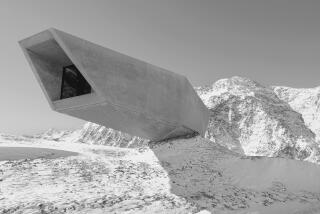9/11 Memorial Needs a Heroic Touch
The eight finalist designs in the World Trade Center memorial competition, now on display in New York City, have failed to generate much enthusiasm. Authorities are already saying that the schemes are just a starting point, but they are also preparing to commit to a “winner” by the end of the month. That’s a mistake.
Sharing a sentimental preoccupation with “loss,” “absence,” “tears” and “memory” -- in the words of their creators -- these designs range from the stark to the bizarre. In the latter category, we have a vaulted, cavernous space shaped by thousands of vertical translucent tubes, which creates a roof that resembles a skating rink perched on a surrealistic honeycomb.
Other schemes are cluttered with gimmicks like images of victims projected against glass walls with water streaming down them. A depressingly minimal design leads visitors down a long, tilted, confining corridor to a space where they watch waterfalls feed into an “abyss.”
None of the schemes offers figurative sculpture -- little or nothing, in fact, is modeled by the human hand. We are left with abstractions, concepts: The art is mostly in the artists’ head, the architecture is rudimentary. Nothing soars. Nothing stirs the soul. These are anti-monuments.
What went wrong?
To start, the competition program tried to be all things to all people. It was cluttered with unfocused demands. The requirement that the huge twin tower footprints be preserved, for example, was a nod toward the victims’ families, but it nurtured a gaggle of disjointed designs spread over the 4.7-acre site. Memorials tend to move us when they’re compact -- symbolically as well as spatially.
But the big problem was the choice of jurors -- rather than representing our artistically pluralistic culture, the majority fall into the modernist camp. Not surprisingly, the finalist schemes reflect the minimalist, abstract idiom in civic art that has been in vogue for a little more than two decades -- since Maya Lin’s Vietnam Veterans Memorial. (Lin herself is on the jury.) But the schemes do not speak well for minimalism as the default idiom for memorial design.
The truth is, aside from the brilliant success of Lin’s wall, conceptual and minimalist abstraction hasn’t given us satisfactory memorials. Consider the design for the Oklahoma City National Memorial -- a field of chairs symbolizing the victims of the bombing facing a pool with unadorned arches at each end. It lacks the powerful focus of Lin’s wall. We reach the bottom with the absurd competition-winning Sept. 11 memorial design for the Pentagon, which features 184 memorial benches cantilevered like diving boards over little tubs of water. The benches point in opposite directions to indicate whether the individual victims were in the Pentagon or on American Airlines Flight 77. The sheer sterility of the imagery in this design is astonishing.
At the World Trade Center site, New York and the nation would be much better served by a heroic, figurative memorial instead of anything resembling the banal competition finalists. This great tradition, after all, has been around for more than two millenniums, not two decades, and the human figure remains the most meaningful of art’s symbols. It has given this country its finest monuments and memorials: the Lincoln Memorial on the National Mall with its majestic evocation of the martyred president, the regimental monuments -- a treasury of figurative symbols -- on the Gettysburg battlefield and the Statue of Liberty.
Figures, whether realistic or allegorical (or both) can be larger than life in every sense. They can embody the American will to persevere, as well as commemorate those lost on Sept. 11. They can exalt the courage and self-abnegation of firefighters and police officers, virtues upon which civilization depends for its survival. They can call us to silence and reverence, as Daniel Chester French’s majestic Lincoln does.
To get such a monument would take another act of courage: Calling a halt to the competition and starting over. This time with a process open to the heroic tradition.
Modernism has all too rarely achieved monumentality, and yet this is precisely the quality we need in a Sept. 11 memorial. New York should build a memorial that, in echoing the grandeur of monuments of the past, will speak not only of the American will to persevere but also of the perseverance of the noblest human ideals across time. It should not only serve those who grieve now, but be a source of inspiration long after the visceral memories of Sept. 11’s horror have faded and the victims’ loved ones are gone.
More to Read
The biggest entertainment stories
Get our big stories about Hollywood, film, television, music, arts, culture and more right in your inbox as soon as they publish.
You may occasionally receive promotional content from the Los Angeles Times.










